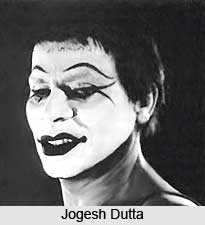 Jogesh Dutta was born in 1942 in Madaripur, East Bengal. Jogesh and his elder brother Suresh Dutta had not much formal schooling to speak of, having come to West Bengal as refugees from East Pakistan when quite young. Inspired by Uday Shankar and Rabindranath Tagore`s dance-dramas, Jogesh began as a stage actor with Sundaram, a Calcutta group. But by 1958, Jogesh Dutta realized that he really wanted to do mime. Chaplin`s films made him aware of the possibilities of mime, his devotion to the form reinforced by Marcel Marceau`s visit to Kolkata in West Bengal in1960, though he could not see the performance, as he could not afford to buy a ticket.
Jogesh Dutta was born in 1942 in Madaripur, East Bengal. Jogesh and his elder brother Suresh Dutta had not much formal schooling to speak of, having come to West Bengal as refugees from East Pakistan when quite young. Inspired by Uday Shankar and Rabindranath Tagore`s dance-dramas, Jogesh began as a stage actor with Sundaram, a Calcutta group. But by 1958, Jogesh Dutta realized that he really wanted to do mime. Chaplin`s films made him aware of the possibilities of mime, his devotion to the form reinforced by Marcel Marceau`s visit to Kolkata in West Bengal in1960, though he could not see the performance, as he could not afford to buy a ticket.
Jogesh Dutta first attracted popular notice at the National Youth Festival in Calcutta that year, and there was no looking back. A delegate to the World Youth Festival in Sofia, Bulgaria in 1968, he undertook frequent and extensive foreign assignments, covering nearly all countries of Europe, North America, and Asia, some of them more than once. Founding his own mime troupe, Padabali, in 1971, he started a school for mime, Jogesh Mime Academy, in 1975. He was also a distinguished teacher of mime at the Department of Drama, Rabindra Bharati University, Kolkata. His creations, now forming a repertoire of over a hundred sketches, are mostly short and hugely funny imitations of scenes from everyday life with a sympathetic undertone for the oppressed and underprivileged.
Most of the titles speak for themselves. Some of the names can be mentioned as The Haircutting Saloon, Walking, The Bus Passenger, When I Was i.e. A Beggar`s Dream, A Naughty Boy, A Thief, A Society Lady, The Operation Theatre, Unemployed Youth, The Old Servant, The Exploited Labourer, Mosquitoes, The New TV Set in the Middle-class Home, Scenes in a Government Office. A few deals with Puranic texts and themes, like Sita and Hanuman, while some, like Long Live the Vietnamese, tackle political and humanistic issues. The Indian Films Division documentary, The Silent Art of Jogesh Dittta in 1983, was shown in fourteen languages.




















